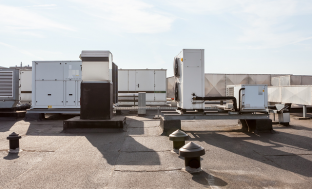latest news
How to work safely around valley gutters

Valley gutters are a common sight on many older, industrial roofs in Scotland.
A valley gutter is formed when two sloping roofs meet at opposite angles and form a ‘V’ shape, or valley. The valley gutter will catch the water from both roofs and allow it to run off of the roof or into the rest of the gutter system, preventing water pooling in between the two slopes and leaking into the building below.
The problem
As with all gutters, valley gutters must be regularly cleaned and maintained, with blockages removed to prevent spillover. If regular maintenance is ignored, leaks can occur and cause damage.
Even if you do carry out regular and in depth maintenance, leaks can still happen due to natural degradation of the materials or even damage caused by birds, heavy wind or rain, leading to repair works.
As with all work carried out at height, maintenance and repair of valley gutters can pose a serious risk to workers tasked with the job.
Unlike standard gutters at the edge of the roof, it is difficult to clean valley gutters using telescopic ‘reach and wash’ systems or elevated work platforms, and it is unlikely you will be able to carry out repairs from the roof edge, meaning you will need to physically access the roof. This makes it near impossible to follow the first rule of the work at height hierarchy: avoid work at height.
Once you access the roof, you are opening yourself up to a whole host of dangers, especially if the building is older, or industrial, which is likely. These roofs can be notoriously fragile and lead to a fall. Many people are unaware that more people fall through a roof than over the edge.
Though you might have existing safety systems such as guardrails in place, these will be useless once you move onto the gutter.
It is important to remember that you should always assume a roof is fragile until you are absolutely certain it is not, and a full risk assessment should be carried out before work begins. Once you have this and the go ahead, you should turn your attention to providing the correct equipment.

The solution
Working on fragile roofs can never be 100 percent safe, but it is important that you follow all guidelines, as well as employ the correct safety solution.
For safer repair and maintenance of valley gutters and the surrounding areas, we supply the Valley-Walk system.
Valley-Walk is a mobile walking frame system for up to two people, designed to provide safer access and mobile roof cover along valley gutters up to a roof pitch of 85 degrees. The system is easily assembled and offers complete safety when working in a valley.
The cushioned outriggers are filled with safety mesh, and provide comfort as well as space to transport a light payload. Valley-Walk can be used in typical symmetrical valleys, but is fully adjustable to suit asymmetrical designs such as ‘northern lights’ roofs.
The system is lightweight, easy to transport and can even be parked on the roof when not in use.
What if the valley is fragile?
Valley gutters themselves can be degraded by running water and weather, or they may have become brittle from the sun, which means they might not be safe to walk on. In this scenario, the best solution would be our Hatch Board-Walk.

The Hatch Board-Walk is a temporary walkway made from high-grade aluminium, which allows you to bridge over a fragile valley whilst still providing access to it via sections which can be easily lifted to carry out work on the area beneath.
Once the work is completed, the staging is simply lowered to create a safe working platform.
Click here to learn more about the Valley-Walk, or call us on 0141 949 1014.





